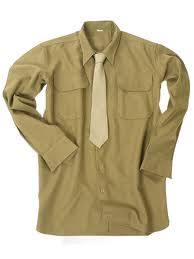SHIRT FLANNEL, OD, COAT STYLE

The basic field uniform of the American soldier in the ETO was a wool shirt and trousers of 1930s pattern. During the war years the same wool shirt and pants, cleaned and pressed and with the addition of a necktie and jacket, also constituted the dress uniform. The standard enlistedmanâs coat style (button-down as opposed to the WWI pull-over) shirt had no epaulets. Frugal officers would sometimes modify the enlistedmanâs issue shirt by adding epaulets rather than buying a shirt privately. It would have been hard for an enlisted man to get away with dressing like an officer so donât buy an officer shirt if you are doing an enlisted impression.
The W.W.II issue shirt is usually encountered today with a divisional patch sewn on the left sleeve and a diamond shaped honorable discharge patch "ruptured duck" on the right breast, both of which youâll have to remove. The shirts are a fine wool flannel cloth that is quite soft. The color is usually a yellowish green (described as mustard) shade of olive drab (OD) but there is occasionally some variation toward browner hues. The 1/2" diameter plastic buttons tend to be reddish brown but there are also occasional variations toward green. Most shirts you encounter will be have a long flap sewn inside the front of the shirt that buttons to the opposite side of the shirt before you button the shirt up normally. This feature is intended to protect the wearer from vessicant gasses (blistering agents like mustard gas). The two buttons sewn at the back of the neck beneath the collar are another anti-gas feature. A separate protective hood is attached at those buttons. Sometimes the gas flap will be removed from a shirt but the buttons behind the collar are almost always present.
If the quartermaster label hasn't been ripped out, it will be found sewn into the bottom right hand seam of the shirt tail. Size information is either ink stamped inside at the back of the neck or embroidered in black block numerals on a white tape tab sewn into the inside collar seam. Try a shirt on before you buy because these shirts have had 50 years to shrink! Never pass up a large size shirt as they are the most difficult to find.
Combat is tough on clothing and a few holes or tears in your uniform is a nice authentic touch. In fact, your field uniform should always be as dirty and wrinkled as possible. You sould consider buying another shirt and pants for use on dress occasions. A tie may not always be required for field events, but again, you will need one for your Class A uniform.